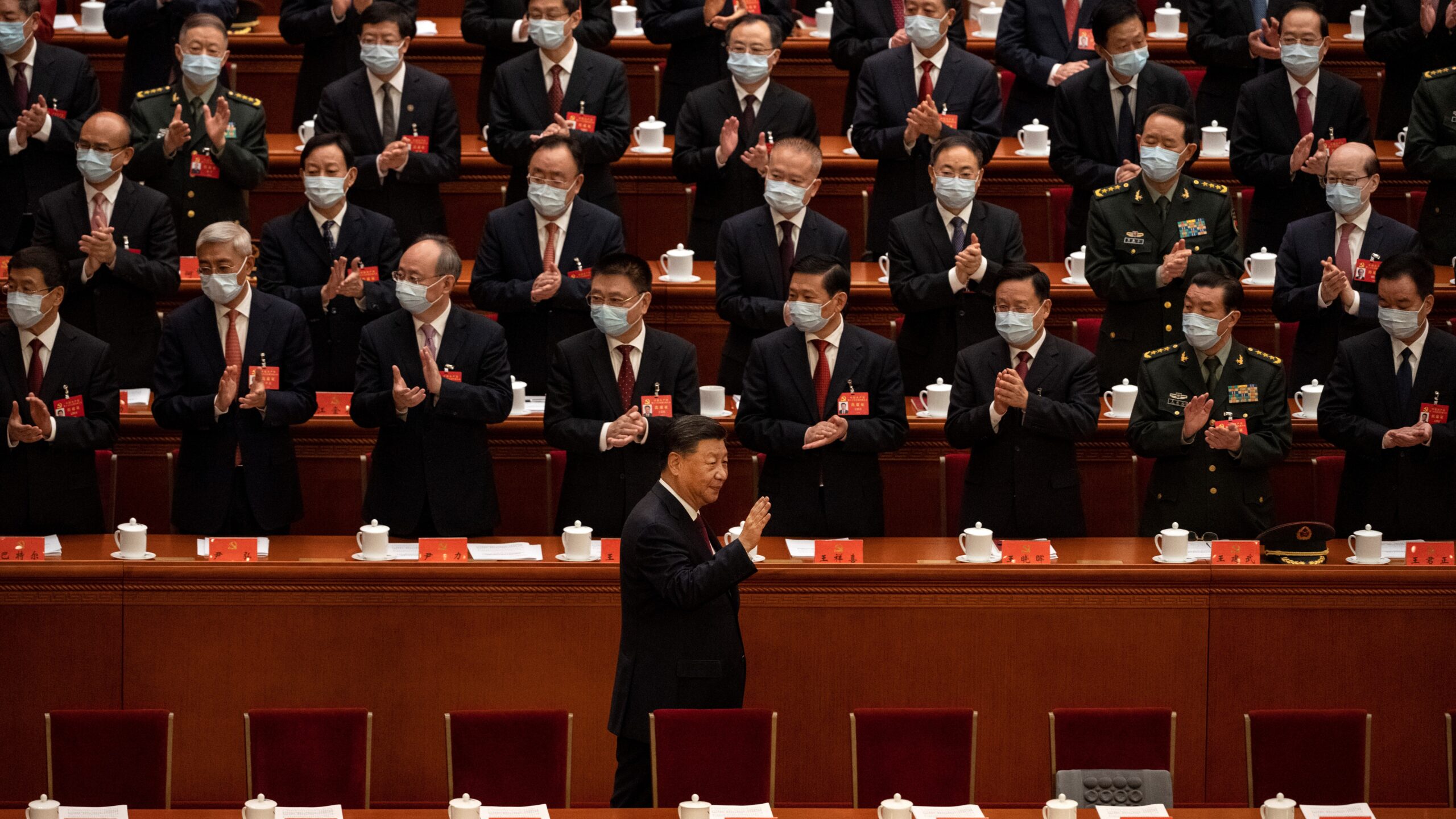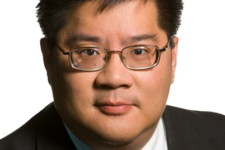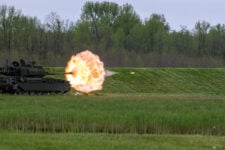
Chinese President Xi Jinping is applauded as he waves to senior members of the government upon arrival at the Opening Ceremony of the 20th National Congress of the Communist Party of China at The Great Hall of People on October 16, 2022 in Beijing, China. (Kevin Frayer/Getty Images)
Few experts know the opaque Chinese military as well as Dean Cheng, recently retired analyst at the Heritage Foundation and other Washington institutions. In the following analysis, Cheng lays out what to watch for as the 20th National Congress of the Chinese Communist Party gets underway, and what it means for the balance of power between the United States, China, and Taiwan.
Xi Jinping is expected to be granted a third five-year term as the General Secretary of the CCP at the Chinese Communist Party’s (CCP) 20th Party Congress. While Xi’s continued hold on power has tended to dominate reporting and speculation about the 20th Party Congress, defense analysts eagerly await military developments that will emerge as well.
This is in part because the Chinese People’s Liberation Army (PLA) is a “party-army,” not a national military. That is, the PLA is, first and foremost, the armed wing of the CCP, and its first loyalty is therefore to the CCP, and not to the state. Consequently, the military and the CCP are far more bound together than most other military and civilian authorities are. The PLA can be ordered to undertake missions that the CCP deems essential, such as cyber economic espionage. At the same time, the military’s interests are far more aligned with the interests of the CCP, especially since every officer above the rank of lieutenant is a member of the CCP.

Dean Cheng
How close are these linkages? The PLA has two seats at the top of the CCP hierarchy, as members of the Political Bureau (Politburo) of the Central Committee of the CCP. These are traditionally held by the two vice chairmen of the PLA’s Central Military Commission (CMC), the two highest ranking uniformed officers in the PLA. This helps ensure that the interests of the PLA are represented at the highest levels of policy-setting.
Military officers, however, have not been part of the Politburo Standing Committee. These are the current seven highest-ranking members of the Politburo, and they are the ultimate power center of the PRC. Since the 19th Party Congress in 2017, the Central Military Commission has been comprised of:
| Title | Name | Service/Department affiliation |
| CMC Chairman | Xi Jinping | Civilian |
| CMC Vice Chairman | Xu Qiliang | PLA Air Force |
| CMC Vice Chairman | Zhang Youxia | CMC Equipment Development Department |
| Defense Minister | Wei Fenghe | PLA Rocket Forces |
| Chief, Joint Staff Department | Li Zuocheng | PLA Ground Forces |
| Chief, Political Work Department | Miao Hua | PLA Navy |
| Secretary of the CMC Commission for Discipline Inspection | Zhang Shengmin | Second Artillery/PLA Rocket Forces |
It is possible that one or both of the vice chairmen positions will be filled by a current CMC member, but it is also possible that all these officers may retire as part of the 20th Party Congress, replaced by the next cohort of PLA officers. In either case, the top military leadership will be comprised of officers approved, and likely selected, by Xi Jinping himself. As important, many of these officers will have gained their last several promotions under Xi Jinping, and will likely reflect Xi’s efforts to fulfill the policy of “rich nation, strong army.”
Things to Watch For
As the new members of the CMC are announced, defense watchers will inevitably try to determine who the new members of the CMC are, as well as the heads of the services and their respective backgrounds. These new officers will be responsible for making the PLA “fully modernized” by 2027. By then the PLA will be fully mechanized, fully informationized and fully intelligence-ized.
And the PLA may well be called upon to engage in actual combat, something that it has not experienced since 1979. This is the period of the “Davidson window,” set by Adm. Phil Davidson when he said China might invade Taiwan by the end of this decade. So, the choice of officers for the CMC, and for the various theater commands, is a central one.
Analysts should go beyond just determining who has been promoted to the top six CMC positions and look at several other factors.
What are these officers’ original service? A major focal point of PLA modernization for the past several decades has been enhancing jointness. Indeed, the General Staff Department, responsible for military planning, training, intelligence activities, and other war-fighting aspects, was renamed the Joint Staff Department (JSD) as part of the massive 2015 reforms. To support the effort to improve joint operations, one should expect senior positions to be filled by members of all the services, rather than primarily the ground forces as was the case prior to the 2015 reforms. Xu Qiliang, for example, is the first PLAAF officer to be made a vice chairman of the CMC.
But the PLA, like the PRC in general, is heavily bureaucratized. So, one challenge will be ensuring that senior positions are, in fact, filled with officers drawn from across the PLA.
Similarly, ossification can result if the same service “owns” certain positions. There are reports, for example, that the JSD position will be filled by Liu Zhenli, currently head of the PLA Ground Forces (PLAGF). As Li Zuocheng, the current head of JSD is a ground forces officer, if Liu takes this top spot, it may indicate that the PLAGF “owns” the JSD position, much as every PACOM/INDOPACOM commander has been a US Navy officer.
On the other hand, as Liu is probably one of the last officers to have fought in the 1979 Sino-Vietnamese war, his promotion may be a way of exploiting that rare commodity in the PLA: combat experience.
Conversely, a greater shuffle may indicate success in promoting true jointness. It might also reflect growing influence of one service or another within the PLA. In particular, it is notable that there is no representation of the PLA Strategic Support Force (PLASSF) at the moment in the top positions on the CMC. As PLASSF has responsibility for China’s space forces, electronic warfare forces, and network (cyber) forces, this is somewhat surprising. Some Chinese writings have at times indicated that the PLASSF is not considered the equivalent of a “service,” but a “branch” drawn from the other services. Elevating a PLASSF officer to membership on the CMC would clarify the PLASSF’s position within the PLA.
What are these officers’ prior postings? Chinese culture has long emphasized “guangxi (关系),” variously translated as “relationships” and “influence.” Indeed, “guangxi” may at times trump formal lines of authority and chains of command. “Guangxi” arises from a range of interactions and common denominators, from being classmates to intermarriage to working together in past postings.
Because PLA officers have regular interaction with civilian counterparts at various points in their career (e.g., through the interactions of the National Defense Mobilization Commission, or as military district commanders with the provincial governor and provincial party secretary), there are “guangxi” networks that span the civil-military divide. Rising civilian leaders will likely bring some military leaders along, as part of those networks, and potentially vice versa.
In addition, each of the new war zone (zhanqu; 战区) or theater commands has a particular focus. The Eastern War Zone command is responsible for Taiwan and Japan. The Southern War Zone command has responsibility for the South China Sea. The Western War Zone command confronts India. Promoting officers from the Eastern War zone potentially indicates particular focus on Taiwan, while officers drawn from the Western War Zone will be more focused on the Sino-Indian border. Their promotion to the CMC may reflect expected priorities for the next five years.
Who occupies other key positions? Much of the discussion on military prospects is focused on the six top positions in the CMC. But the 2015 reorganization saw the establishment of 15 departments, offices, and commissions within the CMC, and the other nine are certainly important as well.
The Logistics Department was renamed the Logistics Safeguarding (or Support) Department, and reoriented towards establishing a more joint logistics posture. PLA analysts are likely closely examining Russia’s performance in Ukraine, especially the logistics shortcomings, to derive “lessons learned.” The new head of the Logistics Safeguarding Department is likely to place much of the PLA’s logistics infrastructure and processes — as well as personnel — under close scrutiny.
RELATED: Nuclear deterrence lessons from Pelosi’s visit to Taiwan
The 2015 reforms saw the establishment of a Training Management Department and a National Defense Mobilization Department. Each department plays a vital role in ensuring that the PLA has fulfilled the three modernizations by 2027. PLA leaders have exhorted for years for more realistic training, knowing that readiness demands not only complete orders of battle but officers and men proficient at the tactical and operational levels of war. The recent operations around Taiwan in the wake of Speaker Nancy Pelosi’s visit were part of the broader training cycle of the PLA. The year 2015 also saw the establishment of the National Defense Mobilization Department.
Meanwhile, the Ukraine war has reminded planners and staffs the world over that modern warfare demands enormous amounts of munitions, spare parts, fuel, and equipment. PLA planners have been working on mobilization policies, procedures, and plans for decades, alongside civilian authorities in the civil-military National Defense Mobilization Commission that spans the PRC from the national level to the townships and villages. The National Defense Mobilization Department is an essential player in ensuring that the PLA does not experience the same kinds of problems currently wracking the Russian armed forces.
With this Party Congress under way in Beijing, Xi Jinping will put in place China’s political and military leadership for the next five years. Should the PRC go to war in that time, this will be the military leadership leading the way.
Dean Cheng, who recently retired from the Heritage Foundation, is a member of the Breaking Defense Board of Contributors.






















